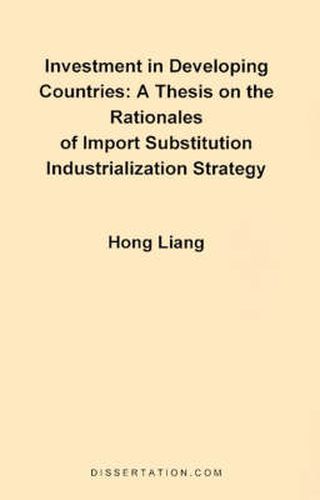Readings Newsletter
Become a Readings Member to make your shopping experience even easier.
Sign in or sign up for free!
You’re not far away from qualifying for FREE standard shipping within Australia
You’ve qualified for FREE standard shipping within Australia
The cart is loading…






This title is printed to order. This book may have been self-published. If so, we cannot guarantee the quality of the content. In the main most books will have gone through the editing process however some may not. We therefore suggest that you be aware of this before ordering this book. If in doubt check either the author or publisher’s details as we are unable to accept any returns unless they are faulty. Please contact us if you have any questions.
The purpose of this research paper is to try to clarify and evaluate the major issues and arguments in the debate on Import Substitution Industrialization Strategy (ISI) between the neoclassical economists and the development economists. In particular, it will focus on some basic underlying models employed by the two schools of thought, rather than on specific policy recommendations given by either school. It will conclude that the critiques against ISI from the neoclassical economists are based on a static equilibrium model, which can not fully comprehend the dynamic relationship between growth and ISI at a macroeconomic level.
This paper starts by examining the historical background and formative influences of ISI, then goes on to compare and contrast the structuralist rationales for ISI and neoclassical rationales against it. The conclusion I reached is that the fundamental rationales behind ISI– the infant industry argument, external economies and linkages effects–remain intellectually valid. The issue of terms of trade has important relevance to development economics but should be studied in a different context.
The general conclusion of this paper is that import substitution as an industrialization strategy remains viable and may be of great importance or less developed countries that want to catch up economically with industrialized countries.
$9.00 standard shipping within Australia
FREE standard shipping within Australia for orders over $100.00
Express & International shipping calculated at checkout
This title is printed to order. This book may have been self-published. If so, we cannot guarantee the quality of the content. In the main most books will have gone through the editing process however some may not. We therefore suggest that you be aware of this before ordering this book. If in doubt check either the author or publisher’s details as we are unable to accept any returns unless they are faulty. Please contact us if you have any questions.
The purpose of this research paper is to try to clarify and evaluate the major issues and arguments in the debate on Import Substitution Industrialization Strategy (ISI) between the neoclassical economists and the development economists. In particular, it will focus on some basic underlying models employed by the two schools of thought, rather than on specific policy recommendations given by either school. It will conclude that the critiques against ISI from the neoclassical economists are based on a static equilibrium model, which can not fully comprehend the dynamic relationship between growth and ISI at a macroeconomic level.
This paper starts by examining the historical background and formative influences of ISI, then goes on to compare and contrast the structuralist rationales for ISI and neoclassical rationales against it. The conclusion I reached is that the fundamental rationales behind ISI– the infant industry argument, external economies and linkages effects–remain intellectually valid. The issue of terms of trade has important relevance to development economics but should be studied in a different context.
The general conclusion of this paper is that import substitution as an industrialization strategy remains viable and may be of great importance or less developed countries that want to catch up economically with industrialized countries.